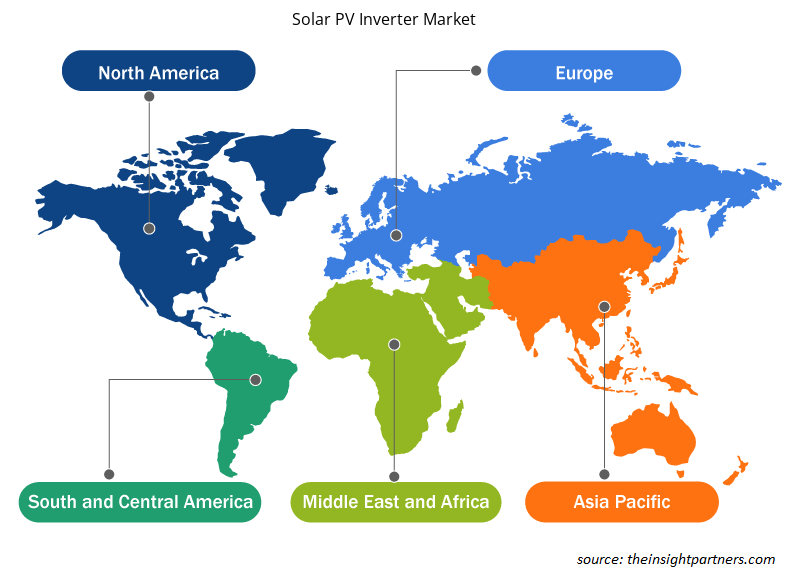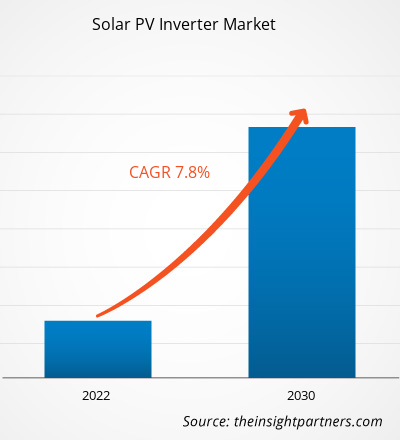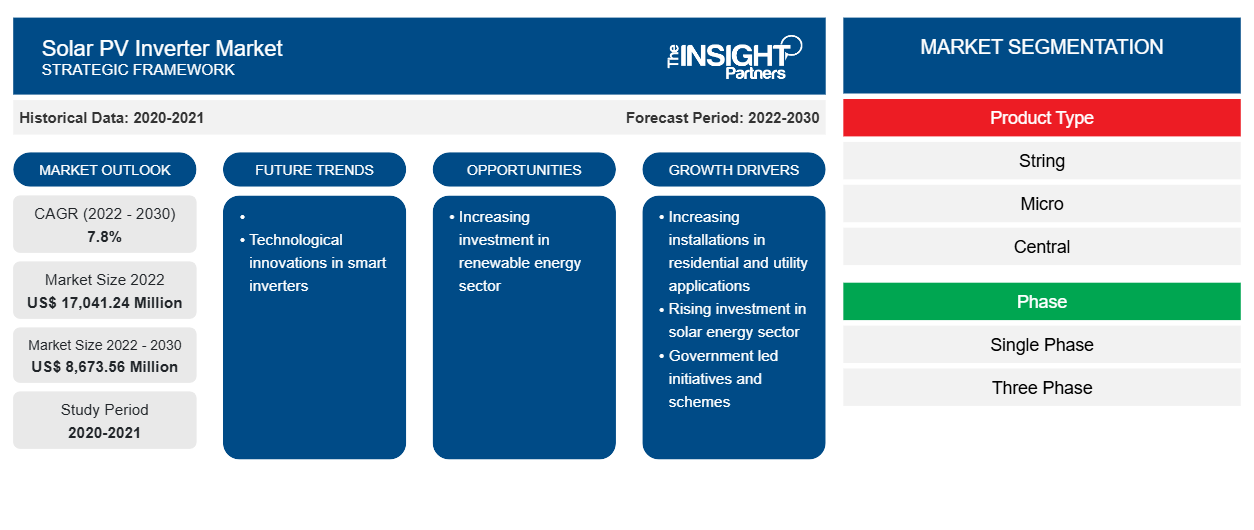Der Markt für Solar-Wechselrichter soll von 17.041,24 Millionen US-Dollar im Jahr 2022 auf 8.673,56 Millionen US-Dollar im Jahr 2030 anwachsen. Der Markt soll in den Jahren 2022–2030 eine durchschnittliche jährliche Wachstumsrate von 7,8 % verzeichnen. Schnelle Investitionen in den Solarenergiesektor, technologische Fortschritte oder die Entwicklung von Solarwechselrichtern und die zunehmende Installation von energiebetriebenen Solaranlagen gehören zu den Schlüsselfaktoren, die den Markt für Solar-Wechselrichter antreiben.
Marktanalyse für Solar-PV-Wechselrichter
Der Markt für Solar-PV-Wechselrichter wird im analysierten Zeitraum voraussichtlich ein beträchtliches Wachstum erfahren, was auf die steigende Anzahl von Solarenergieprojekten sowie die Entwicklung fortschrittlicher Solar-PV-Wechselrichterlösungen zurückzuführen ist. Darüber hinaus sind intelligente Solar-PV-Wechselrichter eine technologisch fortschrittliche Art von Leistungselektronik, die autonome Entscheidungen treffen kann, um das Stromnetz stabil und zuverlässig zu halten. Intelligente Solarwechselrichter funktionieren und gewährleisten einen unterbrechungsfreien Stromfluss ohne Spannungsschwankungen. Dank fortschrittlicher Funktionen wie Spannungs- und Frequenzsensoren können intelligente Solarwechselrichter Netzanomalien erkennen und Feedback an die Netzbetreiber senden. Darüber hinaus gewährleisten intelligente Solarwechselrichter eine bidirektionale Kommunikation mit Kontrollzentren der Energieversorger und steigern so ihre Effizienz in privaten und gewerblichen Anwendungen, was wiederum das Marktwachstum in den kommenden Jahren vorantreiben dürfte.
Marktübersicht für Solar-PV-Wechselrichter
Solaranlagen auf der ganzen Welt, die auf staatliche Anreize und Programme zurückzuführen sind, sowie die zunehmende Installation von Solaranlagen auf Hausdächern wirken sich positiv auf das Marktwachstum für Solar-Wechselrichter aus. Darüber hinaus zählen die zunehmenden Investitionen in den Sektor der erneuerbaren Energien zur Reduzierung des Verbrauchs fossiler Brennstoffe und damit zur Senkung der Kohlenstoffemissionen sowie technologische Innovationen bei Solarwechselrichtern zu den Faktoren, die das Marktwachstum vorantreiben. Die mit hohen Gleichspannungen in Solarwechselrichtern verbundenen Risiken bremsen jedoch das Marktwachstum. Regierungen auf der ganzen Welt starten verschiedene Programme, um die Nutzung von Solarenergie als primäre Energiequelle zu fördern. Die Installation von Solaranlagen auf Hausdächern hilft den Menschen, Strom zu erzeugen und ihn für verschiedene Anwendungen zu nutzen, darunter private, gewerbliche und sogar industrielle.
Passen Sie diesen Bericht Ihren Anforderungen an
Sie erhalten kostenlos individuelle Anpassungen an jedem Bericht, einschließlich Teilen dieses Berichts oder einer Analyse auf Länderebene, eines Excel-Datenpakets sowie tolle Angebote und Rabatte für Start-ups und Universitäten.
-
Holen Sie sich die wichtigsten Markttrends aus diesem Bericht.Dieses KOSTENLOSE Beispiel umfasst eine Datenanalyse von Markttrends bis hin zu Schätzungen und Prognosen.
Treiber und Chancen auf dem Markt für Solar-PV-Wechselrichter
Der Haupttreiber für den Markt für Photovoltaik-Wechselrichter dürfte die zunehmende Zahl von Installationen im Wohn- und Versorgungsbereich sein.
Das zunehmende Streben nach Ökostrom zur Erreichung von Nachhaltigkeit und Energiesicherheit ist der Hauptfaktor für den Einsatz von Photovoltaik, um die steigende Nachfrage zu decken und fossile Brennstoffe als Stromerzeugungsquellen zu ersetzen. Das Wachstum ist hauptsächlich auf zunehmende staatliche Initiativen und Anreize, technologische Fortschritte, ständige Kostensenkungen und die Elektrifizierung ländlicher Gebiete zurückzuführen. Solardachsysteme für Wohngebäude sind einfach zu installieren und erfordern nur minimale Wartung. Der erzeugte Stromüberschuss wird über eine Nettozähleranlage an das Stromnetz verkauft, was zur Senkung der Stromrechnung beiträgt. Angesichts der Erschöpfung der fossilen Brennstoffreserven, der zunehmenden Umweltzerstörung und des Drucks auf die Infrastruktur zur Stromerzeugung haben mehrere Regierungen Subventionen oder Anreize bereitgestellt, um die Nutzung von Solarenergie durch die Bereitstellung von Solarlösungen für Wohngebäude zu fördern .
Erhöhung der Investitionen im Solarenergiesektor
Laut der Internationalen Energieagentur (IEA) wird der weltweite Strombedarf im Jahr 2022 um 8 % steigen. Der Investitionsanstieg im Jahr 2022 ist eine Mischung aus einer zyklischen Reaktion auf die Erholung und einer strukturellen Verschiebung der Kapitalflüsse hin zu saubereren Technologien. Einige der jüngsten Investitionen sind unten aufgeführt:
- Nach Angaben der Solar Power Organization of Europe wurden in der Region im Jahr 2022 Solaranlagen mit einer Leistung von 41,4 GW installiert, was einem Anstieg von 47 % im Vergleich zum Jahr 2021 entspricht.
- Das saudi-arabische Ministerium kündigte im Januar 2023 eine Investition von 226 Milliarden US-Dollar in die Entwicklung sauberer Energie im ganzen Land an. Diese Investition soll für den Ausbau der Wind- und Solarenergieinfrastruktur zur Stromerzeugung genutzt werden, um den landesweiten Bedarf zu decken.
- Chinas Nationale Energiebehörde hat im Jahr 2022 eine Solarinfrastruktur mit einer Leistung von 106 Gigawatt (GW) installiert, was einem Wachstum von 100 % gegenüber dem Vorjahr entspricht.
Somit tragen die steigenden Investitionen in den Sektor der erneuerbaren Energien dazu bei, im Prognosezeitraum Chancen für Akteure auf dem Markt für Solar-Wechselrichter (PV) zu schaffen.
Segmentierungsanalyse des Marktberichts für Solar-PV-Wechselrichter
Wichtige Segmente, die zur Ableitung der Marktanalyse für Solar-PV-Wechselrichter beigetragen haben, sind Produkttyp, Phase, Konnektivität, Anwendung und Kapazität.
- Auf der Grundlage des Produkttyps wurde der Markt für Solar-PV-Wechselrichter in String-, Mikro- und Zentral-Wechselrichter unterteilt. Das Zentralsegment hatte im Jahr 2022 einen größeren Marktanteil.
- Basierend auf der Phase wurde der Markt für Solar-PV-Wechselrichter in einphasig und dreiphasig unterteilt. Das dreiphasige Segment hatte im Jahr 2022 einen größeren Marktanteil.
- Auf der Grundlage der Konnektivität wurde der Markt in Standalone und On-Grid segmentiert. Das On-Grid-Segment dominierte den Markt im Jahr 2022.
- Basierend auf der Anwendung wurde der Markt für Solar-PV-Wechselrichter in Wohn- und Gemeinschaftsmärkte, Gewerbe- und Industriemärkte sowie Versorgungsunternehmen unterteilt. Das Versorgungssegment hatte im Jahr 2022 einen größeren Marktanteil.
- Basierend auf der Kapazität wurde der Markt für Solar-PV-Wechselrichter in unter 5 kW, 5 - 15 kW, 15 - 25 kW, 25 - 50 kW und über 50 kW unterteilt. Das Segment über 50 kW hatte im Jahr 2022 einen größeren Marktanteil.
Marktanteilsanalyse für Solar-PV-Wechselrichter nach geografischer Lage
Der geografische Umfang des Marktberichts für Solar-PV-Wechselrichter ist hauptsächlich in fünf Regionen unterteilt: Nordamerika, Europa, Asien-Pazifik, Naher Osten und Afrika sowie Südamerika.
Der asiatisch-pazifische Raum wird 2022 den Markt für Solar-PV-Wechselrichter dominieren. Die Region Asien-Pazifik umfasst Australien, China, Indien, Südkorea, Japan und den Rest des asiatisch-pazifischen Raums. Im asiatisch-pazifischen Raum ist das Wachstum des Marktes für Solar-PV-Wechselrichter auf die bedeutenden Entwicklungen in der Branche der erneuerbaren Energien zurückzuführen, die auf verstärkte staatliche Strategien und Initiativen in Bezug auf den Klimawandel und Netto-Null-Emissionsziele zurückzuführen sind. Die zunehmenden Investitionen in Solar-Photovoltaikanlagen (PV) und der zunehmende Bau von Solarkraftwerken im Wohnsektor in asiatisch-pazifischen Ländern wie China, Indien, Australien und Japan schaffen lukrative Möglichkeiten für die Akteure des Marktes für Solar-Wechselrichter. In China werden die meisten PV-Produkte oder Solarmodule in abgelegenen Gebieten in riesigen Solarparks installiert, die die erzeugte Energie an Versorgungsunternehmen verkaufen. Satellitenbilder zeigen einen Anstieg dieser großen Solarparks in ganz China. Der drastische Anstieg der Solarenergie im Land ist auf den Strombedarf des Landes und die schwere Luftverschmutzungskrise zurückzuführen. Die chinesische Regierung möchte Finanzinstitute ermutigen, Solaranlagen zu fördern.
Regionale Einblicke in den Markt für Solar-PV-Wechselrichter
Die regionalen Trends und Faktoren, die den Markt für Solar-Wechselrichter während des Prognosezeitraums beeinflussen, wurden von den Analysten von Insight Partners ausführlich erläutert. In diesem Abschnitt werden auch die Marktsegmente und die Geografie von Solar-Wechselrichtern in Nordamerika, Europa, im asiatisch-pazifischen Raum, im Nahen Osten und Afrika sowie in Süd- und Mittelamerika erörtert.

- Erhalten Sie regionale Daten zum Markt für Solar-PV-Wechselrichter
Umfang des Marktberichts über Solar-PV-Wechselrichter
| Berichtsattribut | Details |
|---|---|
| Marktgröße im Jahr 2022 | 17.041,24 Millionen US-Dollar |
| Marktgröße bis 2030 | 8.673,56 Millionen US-Dollar |
| Globale CAGR (2022 - 2030) | 7,8 % |
| Historische Daten | 2020-2021 |
| Prognosezeitraum | 2022–2030 |
| Abgedeckte Segmente |
Nach Produkttyp
|
| Abgedeckte Regionen und Länder |
Nordamerika
|
| Marktführer und wichtige Unternehmensprofile |
|
Dichte der Marktteilnehmer für Solar-PV-Wechselrichter: Auswirkungen auf die Geschäftsdynamik verstehen
Der Markt für Solar-Wechselrichter wächst rasant. Dies wird durch die steigende Nachfrage der Endnutzer aufgrund von Faktoren wie sich entwickelnden Verbraucherpräferenzen, technologischen Fortschritten und einem größeren Bewusstsein für die Vorteile des Produkts vorangetrieben. Mit der steigenden Nachfrage erweitern Unternehmen ihr Angebot, entwickeln Innovationen, um die Bedürfnisse der Verbraucher zu erfüllen, und nutzen neue Trends, was das Marktwachstum weiter ankurbelt.
Die Marktteilnehmerdichte bezieht sich auf die Verteilung der Firmen oder Unternehmen, die in einem bestimmten Markt oder einer bestimmten Branche tätig sind. Sie gibt an, wie viele Wettbewerber (Marktteilnehmer) in einem bestimmten Marktraum im Verhältnis zu seiner Größe oder seinem gesamten Marktwert präsent sind.
Die wichtigsten auf dem Markt für Solar-PV-Wechselrichter tätigen Unternehmen sind:
- Delta Electronics, Inc.
- FIMER SPA
- FRONIUS International GmbH
- GINLONG Technologien
- Huawei Technologies Co., Ltd.
- SMA Solar Technology AG
Haftungsausschluss : Die oben aufgeführten Unternehmen sind nicht in einer bestimmten Reihenfolge aufgeführt.

- Überblick über die wichtigsten Akteure auf dem Markt für Solar-PV-Wechselrichter
Neuigkeiten und aktuelle Entwicklungen zum Markt für Solar-PV-Wechselrichter
Der Markt für Solar-PV-Wechselrichter wird durch die Erfassung qualitativer und quantitativer Daten nach Primär- und Sekundärforschung bewertet, die wichtige Unternehmensveröffentlichungen, Verbandsdaten und Datenbanken umfasst. Im Folgenden finden Sie eine Liste der Entwicklungen auf dem Markt für Solar-PV-Wechselrichter und Strategien:
- Im Februar 2023 unterzeichnete SolarEdge Technologies Inc. einen mehrjährigen Vertrag mit Freedom Forever, dem US-amerikanischen Unternehmen für die Installation von Solaranlagen für Privathaushalte. Dieser Vertrag zielte auf die Lieferung von Smart-Energy-Produkten und -Lösungen für Privathaushalte ab. Im Rahmen dieses mehrjährigen Vertrags zwischen den Unternehmen wird Freedom Forever die Produkte des SolarEdge Home Smart Energy Ecosystem anbieten, darunter den Home Hub-Wechselrichter, Leistungsoptimierer, Heimbatterien, Backup-Schnittstellen und Smart-Energy-Geräte wie das SolarEdge EV-Ladegerät und Lastregler.
- Im April 2022 erweiterte SMA seine Produktlinie um eine neue Reihe von vier Wechselrichtern mit Leistungen von 12, 15, 20 und 25 kW. Sie sollen in Dachanwendungen bis zu einer Größe von 135 kW eingesetzt werden.
Marktbericht zu Solar-PV-Wechselrichtern – Abdeckung und Ergebnisse
Der Bericht „Marktgröße und Prognose für Solar-PV-Wechselrichter (2020–2030)“ bietet eine detaillierte Analyse des Marktes, die die folgenden Bereiche abdeckt:
- Marktgröße und Prognose auf globaler, regionaler und Länderebene für alle wichtigen Marktsegmente, die im Rahmen des Projekts abgedeckt sind
- Marktdynamik wie Treiber, Beschränkungen und wichtige Chancen
- Wichtige Zukunftstrends
- Detaillierte Porter's Five Forces Analyse
- Globale und regionale Marktanalyse mit wichtigen Markttrends, wichtigen Akteuren, Vorschriften und aktuellen Marktentwicklungen
- Branchenlandschaft und Wettbewerbsanalyse, einschließlich Marktkonzentration, Heatmap-Analyse, prominenten Akteuren und aktuellen Entwicklungen
- Detaillierte Firmenprofile mit SWOT-Analyse
- Historische Analyse (2 Jahre), Basisjahr, Prognose (7 Jahre) mit CAGR
- PEST- und SWOT-Analyse
- Marktgröße Wert/Volumen – Global, Regional, Land
- Branchen- und Wettbewerbslandschaft
- Excel-Datensatz
Aktuelle Berichte
Verwandte Berichte
Erfahrungsberichte
Grund zum Kauf
- Fundierte Entscheidungsfindung
- Marktdynamik verstehen
- Wettbewerbsanalyse
- Kundeneinblicke
- Marktprognosen
- Risikominimierung
- Strategische Planung
- Investitionsbegründung
- Identifizierung neuer Märkte
- Verbesserung von Marketingstrategien
- Steigerung der Betriebseffizienz
- Anpassung an regulatorische Trends























 Kostenlose Probe anfordern für - Markt für Solar-PV-Wechselrichter
Kostenlose Probe anfordern für - Markt für Solar-PV-Wechselrichter